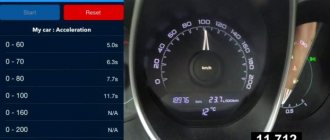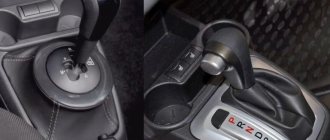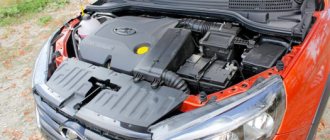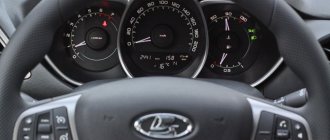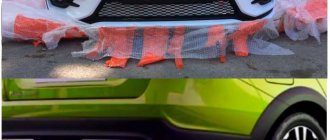The maximum speed of a Lada Vesta car depends on many parameters. Every car is unique. Even with the same engines, but in different bodies, acceleration to 100 km per hour will show different results. The dynamics and maximum speed are greatly influenced by the streamlined body of the car, the rated power of the engine with its weight, as well as the size of the wheels. The larger the wheel diameter, the more comfortable the car will be, but the speed will be lower. Rubber plays an important role. Read the article and learn how to properly accelerate in a Lada Vesta.
What still affects the speed parameter of Lada Vesta
As noted at the very beginning of this article, speed is influenced by a range of factors: gasoline, wheel diameter and open windows. The streamlining of the car is not in last place when it comes to acceleration.
The gearbox affects the boost parameter, but in no case will it increase engine power. If you do not switch the manual gearbox in time, the maximum torque of this gear will not be realized and acceleration will no longer be the same. Professional shifting of a manual transmission will make driving more dynamic. The automatic transmission guarantees normal urban performance.
The replacement comes...
The Renault-Nissan alliance does not have a six-speed automatic or pre-selective transmission for state employees. Therefore, Lada was given a ready-made power unit, already familiar from other Renault models. Engine 1.6 with 113 hp. localized in Togliatti and digests AI-92 gasoline.
A full restyling of Vesta is planned for next year, and with it, I think, the car will change very much. But even now, at the same time as the CVT, Lada has introduced many innovations. All photographs of the material are dedicated to them. The first of these is Diving Blue Metallic. Another fresh color in the palette was black “Maestro”.
A full restyling of Vesta is planned for next year, and with it, I think, the car will change very much. But even now, at the same time as the CVT, Lada has introduced many innovations. All photographs of the material are dedicated to them. The first of these is Diving Blue Metallic. Another fresh color in the palette was black “Maestro”.
In expensive trim levels, the side mirrors are equipped with electric folding. You can play with them using the key or the button on the driver's door. In versions without electric folding, the mirrors remained in the old housings. |
Following the Xray Cross, steering wheel heating came to Vesta. It comes with a leather trim on the steering wheel. |
Content:
This article will focus on car speed. To be more precise, about acceleration to 100 km/h. More than one person noted the excellent dynamics of the Lada Vesta. Let's evaluate how well the car's power is transferred to the road.
The dynamics of a car should be assessed based on what engine and gearbox it is equipped with. Knowing how long it takes a car to accelerate to 100 km/h is necessary for several reasons. Firstly, after repairing or tuning the car, it is necessary to make adjustments to restore dynamics. And secondly, purely out of sporting interest.
Design for the future
The design of the new car, according to many experts, is one of the most successful created by the company's designers. The development of the 2012 Lada Xray concept car was taken as the basis. The new body has two side recesses, which gives it a distinctive and original look. The front part of the body is made with an X-shaped contour of the front parts of the body - the radiator grille, headlights and car bumper. The appearance has become more aggressive, swift, creating the impression of a fast, powerful supercar. The new body design is the development of the company's deputy design director, Steve Martin.
↑ How to test overclocking
When determining the acceleration time of any car, certain conditions must be met. Only if these conditions are met can the test result be considered reliable.
The optimal load on the suspension occurs when 2 people are seated in the Lada Vesta. The total weight of people in the cabin should not exceed 120 kg. There is no need to fill a full tank of fuel so as not to overload the car. Ten liters of fuel will be enough to make the required number of jerks and not stall on the road.
Main overall dimensions and parameters
Lada Vesta is a 4-door spacious sedan, the interior of which is designed for five people. In 2022, the AvtoVAZ concern plans to release a restyled version of the sedan and begin sales of a new body version - the Lada Vesta station wagon.
The characteristics of the Lada Vesta sedan are presented below:
| Parameter | Unit | Meaning |
| Body length/width/height | mm | 4410/1764/1497 |
| Wheelbase | mm | 2635 |
| Front/rear wheel track | mm | 1510/1510 |
| Clearance | mm | 178 |
| Trunk volume | l | 480 |
| Fuel tank volume | l | 55 |
| Curb weight | kg | 1230 |
| Maximum weight | kg | 1670 |
| Drive unit | Front | |
| Front/rear suspension | Independent/semi-independent with anti-roll bar | |
| Front/rear brakes | Disc/drum |
↑ What is the acceleration to hundreds on the Lada Vesta
Before finding out how long it takes a Lada Vesta Sport or other model to accelerate to hundreds in practice, you need to familiarize yourself with the passport data. A Lada sedan with a manual transmission and 1.6 working liters is capable of accelerating to 100 km/h in 11.2 seconds. As for a car with the same engine but an automatic transmission, it will take 3 seconds more to cover the same distance.
Vesta in a sedan with a 1.8 liter engine and 122 horsepower with mechanics accelerates, according to the passport, in 10.2 seconds. The same engine, but complete with manual transmission, is capable of accelerating the car in 12.1 seconds.
The dynamics of Vesta in the station wagon are somewhat worse. A car with a 1.6 liter engine and 106 horsepower with a manual transmission accelerates to 100 km/h in 12.4 seconds, and with an automatic transmission in 14.4 seconds. As for the 1.8 liter engines, the station wagon covers the manual in 10.9 seconds.
Wheels
According to the competition conditions, all teams are equipped with tires from the Japanese company Yokohama with the condition of using 1 set for 1 race.
Wheel replacement is allowed if the tire is mechanically damaged during the race. Pit stops are prohibited during the race. For 1 car, 2 sets of tires are issued: 1 for a dry track, and the 2nd for a wet track. Before the start of the race, the tires are warmed up using special covers with a heating system.
↑ Vehicle speed characteristics
The base model of the Lada Vesta Classic is a car with a 5-speed manual transmission and a 1.6-liter gasoline engine. AvtoVAZ engineers worked closely to ensure that the vehicle had good dynamics, but did not consume an indecent amount of fuel.
The maximum speed that can be achieved while driving a sedan is 178 km/h. The acceleration time to this point is 60 seconds. In practice, it accelerates to the coveted 100 km/h mark in 12.3 seconds. The motor can withstand any load well, even in winter. Of course, we don’t recommend doing this, but it has enough reliability.
Interesting! The most important discovery for many was high stability. Even when the speedometer needle crosses the 100 km/h mark, maneuvering the Lada Vesta is very easy. The car tilts exactly as much as the steering column turns.
Luxe package
In addition to all the above options:
- Fog lights
- Driver's seat armrest with tilt adjustment
- Case for glasses
- Illumination of entry and exit points in the front doors
- Power windows for rear doors
- Rain and light sensors
- Radiator grille, glossy black
- Alloy wheel rims 16"
The Lime option package (X00) makes it possible to paint the body of the Vesta in the original Lime color.
The Multimedia Options Pack (Y4P) will add:
- Rear view camera
- Cruise control and speed limiter
- Control of the multimedia system and cruise control on the steering wheel
- Multimedia system with navigation (7" color display with TouchScreen, FM/AM with RDS function, USB, SD card, AUX, Bluetooth, Hands free), 6 speakers
The Lime Multimedia option package (X4P) repeats the options of the Multimedia package, but also makes it possible to paint the Vesta body in the original Lime color.
The latest optional package for the top trim is called XV Line and includes:
- Pads on the pedals
- Textile rugs
- Rear View Camera
- Cruise control and speed limiter
- Multifunction steering wheel with radio and cruise control
- Multimedia system with navigation (7" color display with TouchScreen, FM/AM with RDS function, USB, SD card, AUX, Bluetooth, Hands free), 6 speakers
- Spoiler
- Decorative exhaust pipe nozzle
Current prices and configurations of Vesta on the official website in PDF format. Download .
Let us remind you that you can familiarize yourself with the current prices in this section. You can get acquainted with the car in more detail from the technical specifications and photographs.
The price for Lada Vesta starts from 514 thousand rubles.
Let us remind you that Lada Vesta has 3 configurations:
In total there are 16 variations with various packages and options. The creators of Vesta have tried their best to meet consumer demands, but their work is not finished yet: as Vesta is released and sold, the consumer’s desire is analyzed, thereby creating new, more profitable configurations.
Table of configurations and costs
| EQUIPMENT | Classic 000 | Classic 6FD | Comfort 000 | Comfort 69X | Luxe Y00 | Luxe X00 | Luxe Y4P | Luxe X4P | Classic 000 | Comfort 000 | Comfort 69X | Luxe Y00 | Luxe X00 | Luxe Y4P | Luxe Y69 | Luxe X4P |
| PRICE, thousand rubles | 514 | 544 | 570 | 585 | 609 | 628 | 633 | 652 | 569 | 595 | 610 | 634 | 653 | 658 | 663 | 677 |
| Engine | 1.6l 16cl., 106 hp | |||||||||||||||
| Transmission | 5st. Mechanics | 5st. "robot" | ||||||||||||||
| SAFETY | ||||||||||||||||
| Driver airbag | + | + | + | + | + | + | + | + | + | + | + | + | + | + | + | + |
| Front passenger airbag with deactivation function | + | + | + | + | + | + | + | + | + | + | + | + | + | + | + | |
| Rear seat headrests 3 pcs. | on all trim levels | |||||||||||||||
| ISOFIX child seat anchors | + | + | + | + | + | + | + | + | + | + | + | + | + | + | ||
| Locking the rear doors against opening by children | on all trim levels | |||||||||||||||
| Automatic door locking when driving | on all trim levels | |||||||||||||||
| Automatic door unlocking and hazard warning lights in the event of a collision | + | + | + | + | + | + | + | + | + | + | + | + | + | |||
| Immobilizer | on all trim levels | |||||||||||||||
| Security alarm | on all trim levels | |||||||||||||||
| Daytime Running Lights | on all trim levels | |||||||||||||||
| Fog lights | + | + | + | + | + | + | + | + | + | |||||||
| Emergency warning system ERA-GLONASS | on all trim levels | |||||||||||||||
| Anti-lock braking system with emergency brake assist (ABS+BAS) | on all trim levels | |||||||||||||||
| Electronic Brake Force Distribution (EBD) | on all trim levels | |||||||||||||||
| Electronic Stability Control (ESC) | on all trim levels | |||||||||||||||
| Traction Control System (TCS) | on all trim levels | |||||||||||||||
| Hill Start Assist (HSA) | + | + | + | + | + | + | + | + | + | + | + | + | + | + | ||
| Engine and engine compartment protection | on all trim levels | |||||||||||||||
| INTERIOR | ||||||||||||||||
| On-board computer | on all trim levels | |||||||||||||||
| Gear shift prompt in the instrument cluster | + | + | + | + | + | + | + | + | ||||||||
| 60/40 split folding rear seat | on all trim levels | |||||||||||||||
| Driver's seat armrest with tilt adjustment 12V socket | + | + | + | + | + | + | + | + | + | |||||||
| Driver and passenger sun visor with mirror Glasses case | + | + | + | + | + | + | + | + | + | + | + | + | + | |||
| Pads on the pedals | + | |||||||||||||||
| Textile rugs | . | |||||||||||||||
| Illumination of entry and exit points in the front doors | + | + | + | + | + | + | + | + | + | |||||||
| COMFORT | ||||||||||||||||
| Electric power steering | on all trim levels | |||||||||||||||
| Height and reach adjustable steering column | on all trim levels | |||||||||||||||
| Adjusting the height of the front seat belts | on all trim levels | |||||||||||||||
| Driver's seat with height adjustment and lumbar support | + | + | + | + | + | + | + | + | + | + | + | + | + | |||
| Cabin air filter | on all trim levels | |||||||||||||||
| Light window tinting | on all trim levels | |||||||||||||||
| Folding key | on all trim levels | |||||||||||||||
| Central locking with remote control | on all trim levels | |||||||||||||||
| Power windows for front doors | on all trim levels | |||||||||||||||
| Power windows for rear doors | + | + | + | + | + | + | + | |||||||||
| Heated front seats | + | + | + | + | + | + | + | + | + | + | + | + | + | |||
| Electric drive and heated exterior mirrors | + | + | + | + | + | + | + | + | + | + | + | + | + | |||
| Heated windshield | + | + | + | + | + | + | + | + | + | + | + | |||||
| Rear parking sensors | + | + | + | + | + | + | + | + | + | + | + | + | + | |||
| Rear View Camera | + | + | + | + | ||||||||||||
| Rain and light sensors | + | + | + | + | + | + | + | + | + | |||||||
| Air conditioner | + | + | + | + | + | + | + | + | + | + | + | + | + | + | + | |
| Cooled glove box | + | + | + | + | + | + | + | + | + | + | + | + | ||||
| Cruise control and speed limiter | + | + | + | + | + | |||||||||||
| Control of the multimedia system and cruise control on the steering wheel | + | + | + | + | + | |||||||||||
| Audio preparation | + | + | + | |||||||||||||
| Audio system (4.3" monochrome display, FM/AM with RDS function, USB, AUX, Bluetooth, Hands free), 4 speakers | + | + | + | + | + | + | + | + | ||||||||
| Multimedia system with navigation (7" color display with TouchScreen, FM/AM with RDS function, USB, SD card, AUX, Bluetooth, Hands free), 6 speakers | + | + | + | + | + | |||||||||||
| EXTERIOR | ||||||||||||||||
| Exterior mirrors with side direction indicators | on all trim levels | |||||||||||||||
| Exterior mirrors and exterior door handles in body color | on all trim levels | |||||||||||||||
| Radiator grille, glossy black | + | + | + | + | + | + | + | + | + | |||||||
| Spoiler | + | |||||||||||||||
| Decorative exhaust pipe nozzle | + | |||||||||||||||
| Wheels stamped 15" | + | + | + | + | + | |||||||||||
| Decorative wheel caps | + | + | + | + | + | |||||||||||
| Cast wheels 15" | + | + | ||||||||||||||
| Spare wheel stamped full size 15" | + | + | + | + | + | + | + | |||||||||
| Cast wheels 16" | + | + | + | + | + | + | + | + | + | |||||||
| Spare wheel cast full size 16" | + | + | + | + | + | + | + | + | + | |||||||
| Original body paint in Lime color | + | + | + | + | ||||||||||||
↑ How to independently measure the dynamics of a car
Measuring Vesta's acceleration time to hundreds is not as simple as it might seem at first glance. The manufacturer does this on special tracks using appropriate equipment. Doing this without special instruments, not to mention doing it yourself, is generally unrealistic. The driver needs to concentrate on the road and change gears in a timely manner.
Russian car enthusiasts, just like foreign ones, can quite accurately measure the acceleration of their car to 100 on a Lada Vesta up to a certain mark. To do this, you need to use a special program called “Auto Acceleration”. I would like to note that it was created by a Russian programmer.
↑ Comparison with main competitors
The main competitors of the Lada Vesta include cars such as Kia Rio, Renault Logan, Volkswagen Polo and Ford Fiesta. The Kia Rio accelerates the fastest. To reach a speed of 100 km/h in a Kia Rio, you need to spend only 10.4 seconds. Ford Fiesta is inferior in dynamics by 0.6 seconds. Next comes the Volkswagen Polo and at the end – Renault Logan.
As for the base engine, it does not have the best speed qualities. But the 1.8-liter 122-horsepower engine with manual transmission puts the car on the same level as the Korean.
The practical achievement of the 100 km/h mark depends on the following points:
- Professional driver capabilities.
- The type of road surface where the car is being tested.
- Accuracy of measuring instruments.
- Weather conditions at a specific point in time.
Often, the owners’ results do not coincide with the passport specifications, but this is normal. Some deviations are possible for the reasons described above.
Acceleration to 100 km/h is a generally accepted indicator of vehicle dynamics. Further indicators are the quarter (402m/quarter mile) and 1 mile.
Let's start with the fact that Vesta is equipped with different power units, which give different dynamic results.
Buyers of AMT and Japanese motors
We must not forget about the second engine, which is planned to be installed on serial Vestas - a 118-horsepower Japanese-made sixteen-valve engine with a capacity, again, of 1.6 liters. A slightly increased power, of course, affects both the maximum speed limit (the speedometer needle can go beyond 180 km/h - up to 185 km/h) and the dynamics of the car (the minimum acceleration time from zero to hundreds is 10.8 seconds) .
The Nissan engine is somewhat more powerful than the VAZ one thanks to a more thoughtful design and efficient operation of the electronic throttle valve. For an inexperienced driver, perhaps the difference is not so great as to overpay for it - however, in this case, the efficiency of the gas pedal recessed to the floor will be much higher and more noticeable.
It is worth noting the optionally installed variator, which replaces the traditional manual transmission. Having the same five steps with the possibility of both manual and automatic gear shifting, the “robot” slightly reduces the driving dynamics - there are slight but significant dips when shifting. On average, the acceleration time on an AMT for connoisseurs of a VAZ engine will be 13.8 seconds, for a Nissan engine - about 12 seconds.
Detailed reports with photos and videos, as a rule, remain after each test drive - and even the lazy can find them using the Internet. In 2016, of course, there will be more sources of information, since the Lada Vesta has already gone on sale in twenty-two cities in Russia - happy owners themselves will be happy to share their knowledge with those who are just thinking about the advisability of purchasing a domestic car.
More details about Lada “Vesta” cars
What is the acceleration to “hundreds” on the Lada Vesta?
Below is a small summary of the dynamics of Vesta with all power units. Readings are taken in good conditions, on 95 gasoline
- Robot 2180 + 21129 motor 106hp. 1.6l - 14.1 sec.
- Mechanics jh3 + 21129 engine 106 hp. 1.6l - 11.2 sec.
- Robot 2180 + 21179 motor 122 hp. 1.8l - 12.1 sec.
- Mechanics 21807 + 21129 engine 106hp. 1.6l - 10.2 sec.
- Mechanics 21807 + 21179 engine 122 hp. 1.8l - . This configuration is not yet available.
So, the blowing of domestic modernized mechanics with a 129 engine showed the best result, accelerating Vesta to 100 km/h in 10.2 seconds. This “record” will last until the pair “Mechanics 21807 + 21179 122 hp engine” appears. 1.8l". Tests are already underway at the moment, so it won’t be long now.
Why is our mechanics faster than the French one by 1 second?
The domestic gearbox has a shorter main pair and a different gear ratio, which made it possible to gain a whole second from the Frenchman. The negative point will be the fact that the domestic box is more voracious. What kind of box do you have? How to determine a manual transmission?
Why is the robot so slow?
The robotic gearbox is designed for a smooth and economical ride, which is reflected in the corresponding fuel consumption. The robot also protects the clutch and shifts gears for a long time.
Transmission
Long-term high-speed racing requires a reliable, well-functioning gearbox with a large margin of safety. The company's specialists chose the model of the British company Xtrack, a sequential 6-speed gearbox with an external adjustment mechanism and paired with an adjustable differential.
According to the WTCC rules, teams are strictly prohibited from making changes to the gear ratios of the gearboxes used, but they can set “pre-stress” by making changes to the adjustment of the cross-axle differential, which has the ability to change depending on the condition of the road, the steepness and number of turns taken, and the speed of the track.
The car has front-wheel drive. To increase the reliability of the transmission, a 3-disc clutch from Apracing and a high-grip disc differential are used.
